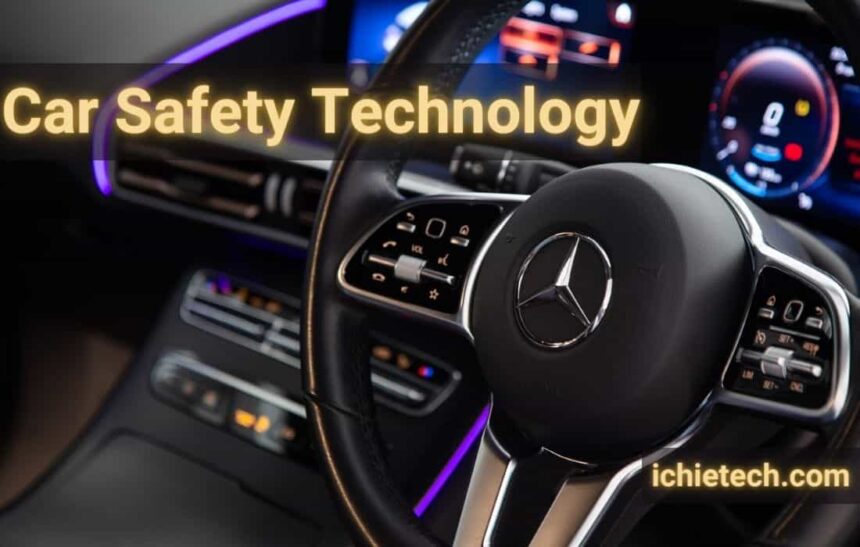In recent years, car safety technology has advanced significantly, offering drivers a number of tools to assist them to prevent accidents and drive more safely. Adaptive cruise control, lane departure alerts, blind spot recognition, and the automated emergency braking are among the advancements. While some of these features may appear to be frills, they may make a big difference in avoiding accidents and saving lives.
One of the most significant advantages of car safety technology is its capacity to assist drivers in being aware of their surroundings and avoiding possible threats. Lane departure warnings, for example, can inform drivers when they are drifting out of their lane, while blind spot identification can assist them in avoiding crashes with other cars. Furthermore, if a driver fails to respond to an oncoming accident, automated emergency braking can apply the brakes, potentially averting major injuries or even fatalities.
Ultimately, auto safety technology has the potential to greatly reduce traffic accidents and make all forms of driving safer. Drivers should keep current and utilize the most recent safety features offered by their automobiles as these advances continue to advance.
In this article, we will look at the numerous forms of automotive safety technologies available today, such as adaptive cruise control, lane departure alerts, blind spot detection, and automated emergency braking. We’ll go through the advantages of these features and how they can assist make driving safer for everyone on the road.
Types of Car Safety Technology

1. Adaptive Cruise Control (ACC)
Adaptive Cruise Control (ACC) is a sophisticated safety technology that automatically adjusts a vehicle’s speed to maintain a safe following distance from the car in front of it. ACC can detect changes in traffic flow and modify the vehicle’s speed as needed, lowering the danger of rear-end incidents caused by sudden stops or slowing traffic. This technology is especially beneficial for drivers who often travel on highways or in congested areas. ACC can assist decrease driver tiredness and enhance overall road safety by allowing the vehicle to maintain a safe following distance and modify its speed as needed.
2. Lane Departure Warning (LDW)
Lane Departure Warning (LDW) is a safety function that monitors a vehicle’s location on the road using sensors. When a vehicle begins to drift out of its lane without signalling, LDW warns the driver with an auditory or visual warning, assisting in the prevention of unintentional lane departures and potential crashes. This technology is especially valuable for weary or distracted drivers, since it may help them stay focused on the road and avoid accidents caused by drifting out of their lane. LDW is becoming more widespread in modern automobiles, helping to enhance overall road safety for both drivers and passengers.
3. Lane Keeping Assist (LKA)
Lane Keeping Assist (LKA) is a safety function that monitors a vehicle’s location on the road using sensors and cameras and actively steers the car back into its lane if it begins to wander out. This technology is used in conjunction with Lane Departure Warning (LDW), which informs the driver if the vehicle drifts out of its lane without signalling. LKA is especially valuable for weary or preoccupied drivers since it can assist minimize accidents caused by unintended lane departures. LKA can assist minimize the likelihood of crashes and enhance overall road safety by actively directing the vehicle back into its lane.
4. Forward Collision Warning (FCW)
Forward Collision Warning (FCW) is a safety function that detects possible accidents with cars or objects in front of the driver using sensors and cameras. When the system detects a probable accident, it issues an auditory or visual warning to the driver, allowing them time to react and take evasive action. Certain FCW systems may also automatically use the brakes to avoid or reduce a collision. FCW is a critical safety element that can aid in the prevention of rear-end collisions, which are among the most prevalent types of accidents on the road. FCW can assist minimize the likelihood of accidents and enhance overall road safety by giving early notice of impending collisions.
5. Automatic Emergency Braking (AEB)
Automatic Emergency Braking (AEB) is a safety technology that detects possible accidents with cars or objects in front of the driver using sensors and cameras. If the driver fails to respond to the Forward Collision Warning (FCW) system’s warning, AEB will automatically use the brakes to prevent or lessen an accident. AEB is especially effective when the driver does not have enough time to respond to a probable accident, such as when travelling at high speeds or in congested areas. AEB can help avoid accidents and minimize the severity of crashes on the road by adding an extra layer of protection.
6. Blind Spot Detection (BSD)
Blind Spot Detection (BSD) is a safety function that monitors the area around a vehicle and detects cars in the driver’s blind spot using sensors. When a vehicle is identified in the driver’s blind area, an auditory or visual warning is sent. BSD is especially important for drivers who regularly change lanes or drive in congested areas since it can assist them to prevent incidents with cars they might not have spotted otherwise. BSD can assist prevent accidents and increase overall road safety by increasing awareness of the vehicle’s surroundings.
7. Rearview Camera
A Rearview Camera is a safety feature that provides a view of the area behind the car by using a camera positioned on the rear of the vehicle. The camera immediately displays the scene behind the car on the infotainment screen when the driver moves into reverse. This technology can be especially handy for drivers who need to back up in small places or navigate busy parking lots. Rearview cameras can also assist in the prevention of accidents involving people or objects behind the car that are not visible in the rearview mirrors. Rearview Cameras can assist enhance overall road safety by offering an extra view of the vehicle’s surroundings.
8. Adaptive Headlights
Adaptive headlights are a safety feature that changes the direction and intensity of a vehicle’s headlights based on their speed and steering angle. This technique enhances vision when driving, especially on dark, curving highways. Adaptive Headlights can assist drivers to identify possible obstacles and dangers sooner by shifting the headlights to point in the direction the vehicle is going, minimizing the likelihood of an accident. They can also help with vision in bad weather, such as rain or fog. Adjustable headlights are becoming more widespread in modern automobiles, contributing to overall road safety and lowering the likelihood of accidents caused by poor sight.
9. Tire Pressure Monitoring System (TPMS)
Tire Pressure Monitoring System (TPMS) is a vehicle safety device that monitors tire air pressure and informs the driver if it falls below a safe level. Underinflated tires are problematic because they increase the risk of blowouts, poor handling, and decreased fuel economy. TPMS aids in the prevention of these problems by providing early warning of low tire pressure. Certain TPMS systems can also provide real-time tire pressure readings, assisting drivers in maintaining correct inflation levels and avoiding possible problems. TPMS is a key safety component that can help prevent accidents and enhance overall road safety, particularly in cars carrying greater loads.
10. Electronic Stability Control (ESC)
Electronic Stability Control (ESC) is a vehicle safety technology that assists in preventing a vehicle from sliding or losing control during rapid movements or dangerous road conditions. As the vehicle loses traction, sensors detect it and instantly apply brakes to individual wheels, assisting in steering the vehicle back on track. This technique is particularly beneficial when a vehicle is at risk of rolling over, such as when travelling on a slippery surface or doing a quick evasive move. ESC is an important safety component that can improve overall road safety by assisting in the prevention of accidents caused by loss of control.
Benefits of Vehicle Safety Technology
| Benefits of Car Safety Technology | Description |
| Reduced Accidents | Car safety technology can help reduce the number of accidents by alerting drivers to potential hazards, such as other vehicles or objects in their blind spots, and by automatically applying the brakes if necessary. |
| Improved Vehicle Control | Some safety technologies, such as Electronic Stability Control, help drivers maintain control of their vehicles, especially in slippery or uneven road conditions. |
| Enhanced Passenger Safety | Car safety technology can help protect passengers by providing features such as airbags, seat belts, and safety sensors that activate in the event of a collision. |
| Better Visibility | Advanced headlights and rearview cameras can help improve a driver’s visibility, reducing the risk of accidents, especially in low-light conditions. |
| Reduced Insurance Costs | Cars equipped with advanced safety features may be eligible for lower insurance premiums, as they are less likely to be involved in accidents. |
| Increased Resale Value | Cars with safety technologies may have a higher resale value, as buyers often look for these features when purchasing a vehicle. |
| Reduced Repair Costs | Advanced safety features can help prevent accidents, which can save car owners money on repairs and maintenance. |
Advantages and Disadvantages of Car Safety Technology
| Advantages of Car Safety Technology | Disadvantages of Car Safety Technology |
| Reduced Accidents: Car safety technology can help reduce the number of accidents, which can save lives and reduce injuries. | Cost: Cars with advanced safety features are often more expensive to purchase and maintain, which can make them less accessible to some buyers. |
| Improved Vehicle Control: Safety technologies such as Electronic Stability Control (ESC) help drivers maintain control of their vehicles, especially in slippery or uneven road conditions. | Reliance: Some drivers may become overly reliant on safety technologies, which can lead to complacency or reckless behaviour. |
| Enhanced Passenger Safety: Car safety technology can help protect passengers by providing features such as airbags, seat belts, and safety sensors that activate in the event of a collision. | Maintenance and Repairs: Some safety technologies require regular maintenance or repairs, which can be costly and time-consuming. |
| Better Visibility: Advanced headlights and rearview cameras can help improve a driver’s visibility, reducing the risk of accidents, especially in low-light conditions. | Technology Malfunctions: Car safety technologies are not infallible, and malfunctions can occur, which may result in accidents or other issues. |
| Reduced Insurance Costs: Cars equipped with advanced safety features may be eligible for lower insurance premiums, as they are less likely to be involved in accidents. | Cybersecurity Concerns: Advanced safety features that rely on computer systems or the internet may be vulnerable to cybersecurity threats, which can compromise the safety of the vehicle and its passengers. |
| Increased Resale Value: Cars with safety technologies may have a higher resale value, as buyers often look for these features when purchasing a vehicle. | Privacy Concerns: Some safety technologies, such as cameras and sensors, may raise privacy concerns for drivers and passengers. |
Challenges and Future of Car Safety Technology
Despite the numerous advantages of automotive safety technology, several obstacles must be addressed in order to assure widespread acceptance and optimum efficacy. The expense of these features, which might make them unaffordable to some users, is one of the key problems. Another problem is ensuring that these systems are correctly integrated and perform fluidly together, especially as cars get more powerful and complicated.
Car safety technology is projected to continue to grow and improve in the future, with new technologies such as pedestrian detection, adaptive cruise control, and autonomous driving becoming more popular. But, as technology progresses, so will the problems, especially in terms of cybersecurity and ensuring that these features are safe and dependable for all drivers. Overall, the future of automotive safety technology looks good, but it will require constant innovation and collaboration to assure its long-term success.
Conclusion
In recent years, car safety technology has improved significantly, providing drivers with a plethora of technological technologies aimed to increase safety and minimize the likelihood of accidents. Car safety technology, such as Forward Collision Warning (FCW) and Automatic Emergency Braking (AEB), as well as Blind Spot Detection (BSD) and Adaptive Headlights, offers drivers an extra layer of protection on the road.
To summarize, automotive safety technology has transformed the driving experience by giving drivers improved awareness of their surroundings as well as an additional layer of security on the road. As this technology advances and improves, we may expect safer, more efficient, and more pleasurable driving experiences for everybody.










